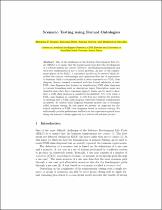JavaScript is disabled for your browser. Some features of this site may not work without it.
- ResearchSpace
- →
- Research Publications/Outputs
- →
- Conference Publications
- →
- View Item
| dc.contributor.author |
Harmse, HF

|
|
| dc.contributor.author |
Britz, K

|
|
| dc.contributor.author |
Gerber, A

|
|
| dc.contributor.author |
Moodley, D

|
|
| dc.date.accessioned | 2015-10-05T07:18:36Z | |
| dc.date.available | 2015-10-05T07:18:36Z | |
| dc.date.issued | 2014-09 | |
| dc.identifier.citation | Harmse H.F, Britz K, Gerber A and Moodley D. 2014. Scenario testing using formal ontologies. ONTO-COM-ODISE 2014: Ontologies in Conceptual Modeling and Information Systems Engineering, Rio de Janeiro, Brazil, 22-23 September 2014 | en_US |
| dc.identifier.issn | 1613-0073 | |
| dc.identifier.uri | http://ceur-ws.org/Vol-1301/ontocomodise2014_10.pdf | |
| dc.identifier.uri | http://hdl.handle.net/10204/8139 | |
| dc.description | Ontologies in Conceptual Modeling and Information Systems Engineering, Rio de Janeiro, Brazil, 22-23 September 2014. Due to copyright restrictions, the attached PDF file only contains the abstract of the full text item. For access to the full text item, please consult the publisher's website | en_US |
| dc.description.abstract | One of the challenges in the Software Development Life Cycle (SDLC) is to ensure that the requirements that drive the development of a software system are correct. However, establishing unambiguous and error-free requirements is not a trivial problem. As part of the requirements phase of the SDLC, a conceptual model can be created which describes the objects, relationships and operations that are of importance to business. Such a conceptual model is often expressed as a UML class diagram. Recent research concerned with the formal validation of such UML class diagrams has focused on transforming UML class diagrams to various formalisms such as description logics. Description logics are desirable since they have reasoning support which can be used to show that a UML class diagram is consistent/inconsistent. Yet, even when a UML class diagram is consistent, it still does not address the problem of ensuring that a UML class diagram represents business requirements accurately. To validate such diagrams business analysts use a technique called scenario testing. In this paper we present an approach for the formal validation of UML class diagrams based on scenario testing. We additionally provide preliminary feedback on the experiences gained from using our scenario testing approach on a real-world software project. | en_US |
| dc.language.iso | en | en_US |
| dc.publisher | CEUR-WS | en_US |
| dc.relation.ispartofseries | Workflow;14534 | |
| dc.subject | Software Development Life Cycle | en_US |
| dc.subject | SDLC | en_US |
| dc.subject | Ontologies | en_US |
| dc.subject | Conceptual modeling | en_US |
| dc.subject | Information systems engineering | en_US |
| dc.title | Scenario testing using formal ontologies | en_US |
| dc.type | Conference Presentation | en_US |
| dc.identifier.apacitation | Harmse, H., Britz, K., Gerber, A., & Moodley, D. (2014). Scenario testing using formal ontologies. CEUR-WS. http://hdl.handle.net/10204/8139 | en_ZA |
| dc.identifier.chicagocitation | Harmse, HF, K Britz, A Gerber, and D Moodley. "Scenario testing using formal ontologies." (2014): http://hdl.handle.net/10204/8139 | en_ZA |
| dc.identifier.vancouvercitation | Harmse H, Britz K, Gerber A, Moodley D, Scenario testing using formal ontologies; CEUR-WS; 2014. http://hdl.handle.net/10204/8139 . | en_ZA |
| dc.identifier.ris | TY - Conference Presentation AU - Harmse, HF AU - Britz, K AU - Gerber, A AU - Moodley, D AB - One of the challenges in the Software Development Life Cycle (SDLC) is to ensure that the requirements that drive the development of a software system are correct. However, establishing unambiguous and error-free requirements is not a trivial problem. As part of the requirements phase of the SDLC, a conceptual model can be created which describes the objects, relationships and operations that are of importance to business. Such a conceptual model is often expressed as a UML class diagram. Recent research concerned with the formal validation of such UML class diagrams has focused on transforming UML class diagrams to various formalisms such as description logics. Description logics are desirable since they have reasoning support which can be used to show that a UML class diagram is consistent/inconsistent. Yet, even when a UML class diagram is consistent, it still does not address the problem of ensuring that a UML class diagram represents business requirements accurately. To validate such diagrams business analysts use a technique called scenario testing. In this paper we present an approach for the formal validation of UML class diagrams based on scenario testing. We additionally provide preliminary feedback on the experiences gained from using our scenario testing approach on a real-world software project. DA - 2014-09 DB - ResearchSpace DP - CSIR KW - Software Development Life Cycle KW - SDLC KW - Ontologies KW - Conceptual modeling KW - Information systems engineering LK - https://researchspace.csir.co.za PY - 2014 SM - 1613-0073 T1 - Scenario testing using formal ontologies TI - Scenario testing using formal ontologies UR - http://hdl.handle.net/10204/8139 ER - | en_ZA |






